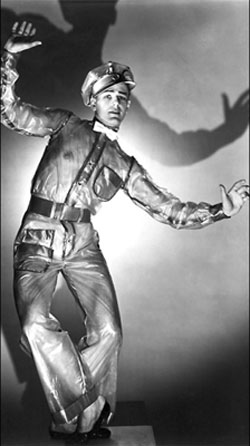 Dance is always about music, and music is, more often than not, about dance. But how does dance animate music, and music animate dance? This seemed to be the central question when I caught Program 1 of the San Francisco Ballet’s 75th anniversary season at the War Memorial Opera House February 9th. Classical ballet and modern dance sometimes plays against and even ignores the music’s rhythmic structure which would never happen in the deservedly popular Dancing With The Stars. But we rightly or wrongly cut the highbrow forms a bit more slack.
Dance is always about music, and music is, more often than not, about dance. But how does dance animate music, and music animate dance? This seemed to be the central question when I caught Program 1 of the San Francisco Ballet’s 75th anniversary season at the War Memorial Opera House February 9th. Classical ballet and modern dance sometimes plays against and even ignores the music’s rhythmic structure which would never happen in the deservedly popular Dancing With The Stars. But we rightly or wrongly cut the highbrow forms a bit more slack.
Virgil Thomson’s music for SF Ballet’s founding choreographer Lew Christensen’s Filling Station (1938) brought these thoughts center stage. And though the composer has defined his score as a collection of waltzes, tangos, a fugue, a Big Apple, a hold up, a chase, and a funeral, one was barely aware of these disparate forms. Instead, what caught the ear and eye was the happy disjunction between these elements, not their literalness. But that’s odd when you consider how this ballet, to a story by Lincoln Kirstein, is routinely described as a pop piece.
Well, maybe, but one which uses vernacular movement — way before the Judson Church crowd did it — in still fresh, even startling ways. The moves for James Sofranko’s filling station attendant Mac were exaggerated but somewhat naturalistic too. But the gestures Christensen devised for the other dancers, like the hilariously bombed Rich Girl Erin McNulty, tended to be more stylized, as Thomson’s music shifted gears — jubilant one moment, deadly serious the next — as in his viola-dominated tango for her, which didn’t make rational, but emotional sense. Thomson was always a subtle and sly composer, and his clever but utterly sincere moves were on full display here, and. Martin West’s orchestra made the music go on many levels. Thomson once told me that everybody’s after freshness and this score couldn’t have been more fresh, and perfectly modern because of that.
Modernist choreographers have tried their hand at setting dances on Bach’s music, with Balanchine’s Concerto Barocco being one of the most famous. SF Ballet Artistic Director Helgi Tomasson, who’s sometimes been too much of a Balanchine acolyte, seemed to break free of the master in his 7 For Eight (200 ), to music from Bach keyboard concertos composed between 1729 and 1741, and the music’s mathematical lucidity and calmly ordered sequences seemed to make him go further and deeper than he usually does.
Bach is regularly advertised as peerless and one certainly felt that here in Tomasson’s 7 sequences for 8 dancers which were as contained and deeply expressive as the music, with 3 duos alternating with 1 trio, 1 quartets, and 1 solo.
Company star Joan Boada shone, but so did all the other dancers here who negotiated Tomasson’s from a classical vocabulary moves with both elegance and gravity. David Finn’s subtly modulated lighting scheme of mostly bluish greys and off blacks made the stage pictures both beautiful and highly suggestive ,which the costumes by Sandra Woodall — who dressed Kronos years ago — unobtrusively complemented The expert piano soloist here was Michael McGraw.
Would that Balanchine’s 1967 mostly general dance, Diamonds, from Jewels, were as successful or interesting as the two dances which preceded it. Instead it came off as a kind of white on white version of Balanchine’s hommage to Sousa; The Stars and Stripes, with the stage almost always full of the 32 member corps executing endless formations and deformations with lots of chandelier-like port-a-bras, which though meant to look elegant ended up being cloying, with 4 of the 5 movements of Tchaikovksy’s 3rd Symphony serving as the score. Balanchine was as much as an entertainer as a high art guy–his long association with Stravinsky– but this just seemed like admirably danced fluff. Martin West’s pit band accompanied with effortless grace,well-judged tempos, and transparent ensemble throughout. And in none of the 3 pieces did he ever encourage his orchestra to push. This is a deservedly acclaimed company with a very fine orchestra.
 Alex Ross has a splendid piece titled
Alex Ross has a splendid piece titled  Growing up in a podunk, nil-culture, border-ish town in Washington State, half of my classical education came by way of drifty, static-filled, late-night AM listening to the CBC. Not only work by Stravinsky, Boulez, and Xenakis, but a whole raft of amazingly strong Canadian composers: R. Murray Schafer, John Rea, Claude Vivier and the like. Many of these recordings were CBC productions, and were something that gave me an early admiration of our northern neighbor’s commitment to the arts.
Growing up in a podunk, nil-culture, border-ish town in Washington State, half of my classical education came by way of drifty, static-filled, late-night AM listening to the CBC. Not only work by Stravinsky, Boulez, and Xenakis, but a whole raft of amazingly strong Canadian composers: R. Murray Schafer, John Rea, Claude Vivier and the like. Many of these recordings were CBC productions, and were something that gave me an early admiration of our northern neighbor’s commitment to the arts. Dance is always about music, and music is, more often than not, about dance. But how does dance animate music, and music animate dance? This seemed to be the central question when I caught Program 1 of the San Francisco Ballet’s 75th anniversary season at the War Memorial Opera House February 9th. Classical ballet and modern dance sometimes plays against and even ignores the music’s rhythmic structure which would never happen in the deservedly popular Dancing With The Stars. But we rightly or wrongly cut the highbrow forms a bit more slack.
Dance is always about music, and music is, more often than not, about dance. But how does dance animate music, and music animate dance? This seemed to be the central question when I caught Program 1 of the San Francisco Ballet’s 75th anniversary season at the War Memorial Opera House February 9th. Classical ballet and modern dance sometimes plays against and even ignores the music’s rhythmic structure which would never happen in the deservedly popular Dancing With The Stars. But we rightly or wrongly cut the highbrow forms a bit more slack.